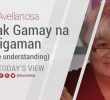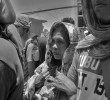(First of two parts)
Eid Mubarak! As the Muslim Ummah (community) commemorates the Eid’l Adha today, or the Feast of the Sacrifice, let us also remember our Moro brothers and sisters who sacrificed their lives in defense of our community and in aspiration for an independent nation, or a bangsa (nation) for the Moro people.
It’s good to be back at the home page of Davao Today, and I’m very thankful to the editors and the staff for providing me the space where I can share my conversations with Moro folks in the grassroots regarding their views on our current situation. Hence, I chose the name Suara Miskin for the column, which in Arabic and Bahasa means “the voice of the poor.” It is a name that is also common to all the 13 tribes that constitute the Moro ethnolinguistic group in the Philippines.
This title sort of got stuck on me during 2007 elections where my party-list organization Suara Bangsamoro ran for a seat in Congress. The people who saw me walking while campaigning in Sulu started calling our group Suara Miskin. This was probably because we were the only Moro party-list organization that did not have funds to give money to voters or use fancy cars during campaign. Some even suggested that we should just buy votes at the Commission on Election instead of sweating it out in the streets, just what other party-list groups of Moro politicians do. I guess that was their way of appreciating our bravery and confidence in aspiring that a party-list organization of Moro members could win even without shedding huge sums of money.
But even then, the party-list election was not a level playing field.
I guess, this is where I should take off in explaining my views and also borrowing from the Moro people I have conversed with, about the Framework Agreement on the Bangsamoro (FAB).
Now that the euphoria over the signing in Malacanang is over, the Moro people are now compelled to scrutinize what we really gained from negotiations with the government. I want to look at it at a different lens, one that is not clouded with joy and pretense that peace has come at last after the signing, but more of grounded reaction.
What’s next? As what GPH Panel Chair Marvic Leonen during the the 32nd GPH-MILF Formal Exploratory Talks has said, “the truth is that our work does not end here; it has become more complicated.” It is in the succeeding weeks and months that both panels will need to flesh out the contents of the framework agreement through the technical working groups who will craft the annexes on power-sharing, wealth-sharing and normalization. Prime Minister Najib bin Tun Abdul Razak of Malaysia also said during the signing of the FAB on October 15, that the FAB is a “historic document but it does not solve all the problems,” and only serves as an outline in finding “lasting peace” in Mindanao.
This is not to belittle the FAB, but it means that the Moro people will also have to work to make sure that the FAB is not made favorable, or as what the peace panel chair of the National Democratic Front of the Philippines (NDFP) Luis Jalandoni has commented, “tilted” towards the government. Unlike the 1996 GRP-MNLF Final Peace Accord, the FAB did not seal or limit the struggle of the Moro people for right to self-determination to an agreement, but offers more room for debate and people’s participation.
But this is the ideal set-up or a come-on from the Aquino administration—whose catchphrase “daang matuwid”– made me think that it is out to railroad the FAB to its favor. The FAB will journey the usual route of creating a bill or just like the organic act creating the Autonomous Region in Muslim Mindanao (ARMM). In the government’s roadmap, the President will issue an executive order creating the Transition Commission which will then draft an organic act creating the Bangsamoro (the new autonomous political entity). This will be enacted by Congress and will pass through plebiscite. This will be similar to the process that the Organic Act and the 1996 Final Peace Accord went through. At that time, Moro lawmakers who crafted the bill complained that Congress watered down the bill, shedding it of its original intentions.
This is the battle that the MILF will have to face, for they will compose majority of the transition commission. They will also have to face the anger of Moro National Liberation Front founding chair Nur Misuari. I believe this anger should not be directed at a fellow Moro liberation front and at Malaysia, who served as the third party facilitator of the talks, but rather at the Philippine government who “abrogated” the 1996 Final Peace Accord.
Most of the people I’ve talked to are confused as to the state of the 1996 Final Peace Accord with the FAB in place. The current state and covered areas of the ARMM is only the first phase of the implementation of the Accord, the second phase is for the expansion of areas and functions which, according to Prof. Misuari, the government did not deliver.
It pains me to see that the two revolutionary fronts are fighting each other over the spoils of the ARMM while the central government continues to squander our “homeland.” For what good is determining the boundaries of our land, when the government continues its hold to our resources, above and underground. In the FAB and the 1996 Peace Accord, the government has a lot of stake in exploration and utilization of our resources, presumably they will be under the Aquino administration’s economic program Public-Private Partnership which gives license to Forbes Magazine’s 40 rich Filipino business tycoons to control business that hold water services, electricity, airport, road, transportations, schools, hospitals and other businesses under PPP contracts. This also means the Executive Order 79 for Mining which gives free rein to foreign corporations to mine. Full ownership will come next as soon as Congress will change the provision on national patrimony in the Philippine Constitution. This is where the government and the MILF converge in the roadmap to peace, the necessity for a charter change to accommodate the creation of the Bangsamoro.
However, until the root of the problems pervading in the Moro communities is not resolved, charter change or an autonomous entity will be out of context. Reforms will remain a catchphrase for the government at the detriment of the people struggling for change. I hope the Bayanihan figurine given by President Aquino to chairman Murad as a token for peace during the signing is not his expression of implementing his administration’s counter-insurgency Oplan Bayanihan. The call for reform dominates in Oplan Bayanihan, sort of an image make-over of the bloody Oplan Bantay Laya which claimed lives of hundreds of activists and masses.
Amira Ali Lidasan is an Iranun and hails from a prominent Moro clan in Maguindanao. She is an observer of Moro politics and an activist. Write to Amira at amirah.lidasan@gmail.com.
Views and opinion expressed in this column are solely those of the author and do not necessarily reflect the views of Davao Today.


![[STANDPOINT] Illegal drugs and the NIMBY mindset](https://davaotoday.com/wp-content/uploads/2016/09/Mags-Maglana_UPMIN-Sept.-20-110x100.jpg)








